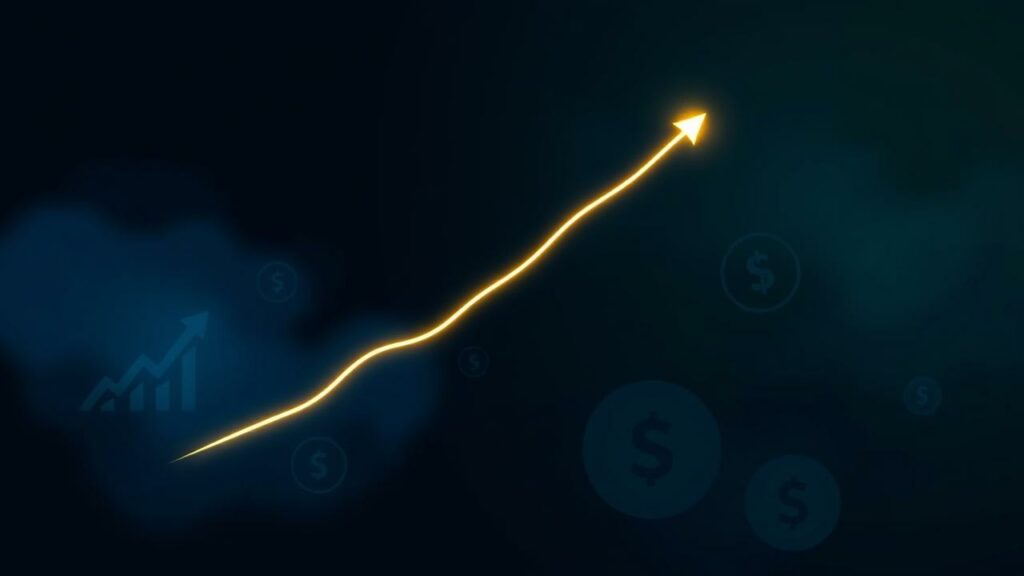Our Financial North Star: How to Invest for True, Long-Term Freedom
The fluorescent lights of the drafting table hummed, a low, predatory sound that vibrated straight through her molars. For weeks, they had been her only sun, the harsh glare bleaching the color from her world. Outside, Chicago was alive, but in here, there was only the smell of old paper, anxiety, and the recycled air of a client’s impossible demands. This project, a soulless glass box masquerading as architecture, was paying the bills but stealing her life in microscopic increments.
Her name was Alejandra, and she was an architectural restoration specialist, a person who breathed life back into forgotten beauty. Yet here she was, designing a mausoleum for a corporate ego. That night, a tremor of defiance ran through her. It wasn’t a sudden rage, but a deep, cold certainty. She opened her laptop, the glow illuminating the exhaustion etched on her face. She looked not at blueprints, but at a simple graph. A line, inching upwards, methodical and relentless. Her investments. A quiet, growing rebellion she had started years ago.
This isn’t just about money. It’s about the moment you realize you have the power to say “no.” It’s about buying back your mornings, your energy, your soul. It’s about having the resources to walk away from the humming fluorescent lights and toward a life you actually design. This is the raw, beating heart of investing for long-term freedom. It’s not a dream. It is a decision, followed by a series of deliberate, powerful actions.
The Unchained Path: Your Core Commands
The journey from servitude to sovereign is not paved with lottery tickets or speculative gambles. It is built, brick by methodical brick, on a foundation of unshakeable principles. This is your condensed battle plan:
- Define Your Exit: You must know, with chilling clarity, what freedom looks like. Calculate the exact monetary figure that buys back your time. This is not a dream; it is a destination.
- Unleash the Unseen Force: Understand that time, not timing, is your greatest weapon. You will learn to harness the exponential power of compounding, a force that works for you even while you sleep.
- Automate Your Rebellion: Remove your greatest enemy from the equation: your own emotion. Set up automatic, recurring investments that build your fortress of freedom without requiring your daily courage.
- Construct an Unbreakable Shield: You will never bet the farm on one horse. Diversification is the law. It’s the difference between a crisis-proof financial battleship and a flimsy raft at the mercy of the storm.
Your Freedom Number: More Than Just a Figure on a Spreadsheet
There’s a number that will set you free. It’s not imaginary. It is a concrete, calculable sum of assets that, once reached, generates enough income to cover your life’s expenses indefinitely. This is the core target of investing for financial independence. But if you see it as just a number, you will fail.
You must feel it. What does it smell like? The salt air of a coast you’ve only seen in pictures? The sawdust of a workshop you can finally build? The simple, clean air of a Tuesday morning with no alarm clock shrieking in your ear?
Forget abstract goals. Get viscerally specific. Itemize the cost of your liberated life. Is it $4,000 a month? $8,000? This clarity transforms a vague wish into a tangible target. It becomes your North Star, the fixed point guiding every financial decision you make. This calculation is the first, indispensable step in your financial independence roadmap, and it often begins with the unglamorous but essential work of budgeting for independence and mapping out your current cash flow.
The Unseen Force: Compounding as Your Silent Revolution
A single drop of water, falling on a stone. It seems to do nothing. A thousand drops, a million drops, and a decade later, the stone is worn through. This is compounding. It is the eighth wonder of the world, a patient, brutal, unstoppable force that will either work for you or against you.
When you invest, your money earns returns. The next year, you don’t just earn returns on your original money; you earn returns on those returns. It’s a snowball rolling down an infinitely long hill, starting as a fist-sized lump and growing into an avalanche of wealth. Your only job is to get the snowball rolling and get out of its way. Every dollar you delay investing is a decade of exponential growth you’ve sacrificed on the altar of procrastination.
The Enduring Arsenal: Bedrock Long-Term Investment Strategies
The path to freedom is not about finding a secret loophole or a “hot tip” whispered in a dark alley. Those are traps for the desperate. True, lasting wealth is built upon proven, battle-tested long term investment strategies that anyone can master.
First is the path of the passive warrior: buying broad market index funds and ETFs. You don’t try to beat the market; you become the market, harnessing its collective growth with minimal cost and effort. Second is the path of the income hunter: building a portfolio of dividend-paying stocks, creating a river of cash flow that grows year after year. Finally, there’s the path of the landlord: using real estate to build tangible equity and generate rental income. Each path can lead to freedom; the wise often walk a combination of all three.
The Automation of Power: Taming the Beast with Dollar Cost Averaging
The night shift at the logistics hub was a sensory assault. The groan of hydraulics, the relentless beep of reversing trucks, the sour tang of diesel fumes clinging to his clothes. Brayden moved through this mechanical chaos, a ghost in a high-vis vest. The weight of it all—the mortgage, the second kid on the way, the feeling that he was just a cog—was a physical presence, a tightness in his chest. His rebellion wasn’t loud. It was a phantom transaction that left his bank account at 9 AM on the 15th of every month. Two hundred dollars. Every single month, without fail, into a simple market index fund.
He wasn’t trying to time the market. He didn’t have the energy. This was dollar cost averaging in its purest form. When the market was high, his $200 bought fewer shares. When it panicked and plunged, his same $200 bought more. He was methodically buying, indifferent to the daily news cycle of fear and greed. He was building his escape hatch, not with one heroic leap, but with a thousand small, disciplined steps. It was a secret he kept, a quiet promise of a future where his time was his own, humming silently beneath the noise of the warehouse.
Your First Step From the Ledge: The Best Investments for Beginners
Staring into the abyss of “the market” can feel like staring into a hurricane. So don’t. You don’t need to understand every eddy and gust. The best investments for beginners are not about complexity; they are about elegant simplicity.
Your starting point is almost always a low-cost, broad-market index fund or ETF (Exchange-Traded Fund). Think of it like this: instead of trying to find the one winning needle in a continent-sized haystack, you buy the whole haystack. For a tiny fee, you own a sliver of hundreds, or even thousands, of the world’s best companies. You are instantly diversified. You have harnessed the engine of capitalism. It is the single most powerful, effective, and neurologically calming first step you can take.
A Direct Line to Freedom’s Blueprint
Sometimes the noise is too much. You need a clear, unwavering voice to cut through the jargon and hand you a map. This video does just that, presenting one of the most reliable and straightforward paths to building a life where work is optional, not a mandate.
Source: The Simplest Path to Financial Freedom via YouTube
The Dance of Fire and Earth: Mating Stocks vs. Bonds in Your Portfolio
Imagine your portfolio as a high-performance vehicle. Stocks are the engine—the fire, the volatility, the raw power that generates explosive growth over time. They are thrilling, but they can rattle the entire frame. Bonds are the suspension and the frame itself—the earth, the stability, the shock absorbers that smooth out the ride. They won’t win you the race on their own, but they’ll make sure you don’t fly apart on the rough patches.
The eternal debate of stocks vs bonds isn’t about choosing a winner. It’s about finding the perfect harmony for your stage in life. When you’re young, you can afford a bigger engine and a stiffer ride—more stocks. As you near your freedom date, you begin to value a smoother journey, adding more bonds to protect the wealth you’ve already built. It’s a dynamic dance, not a static choice.
Ride the Wave, Don’t Predict the Tides: Mastering Index Fund Investing
Wall Street spends billions of dollars and hires legions of the world’s most overconfident minds to do one thing: try to beat the market. And year after year, the vast majority of them fail. There’s a wry, beautiful humor in that, isn’t there? They lose to a simple, automated strategy you can set up in your pajamas.
Mastering index fund investing is an exercise in radical acceptance. You accept that you cannot predict the future. You stop trying to pick winning stocks and instead buy a slice of all of them. By owning a total stock market index fund, you are guaranteed to capture the market’s full return over time. It’s the art of winning by refusing to play a loser’s game.
The Swiss Army Knife of Investing: How to Invest in ETFs for Beginners
Walking into the investment world can feel like being asked to perform surgery with no training. Exchange-Traded Funds (ETFs) are like being handed a pre-packaged, sterilized, all-in-one surgical kit. They are bundles of assets—stocks, bonds, commodities—that trade as a single stock.
Want to invest in etfs for beginners? It’s brutally simple. You can buy an ETF that tracks the entire S&P 500. You can buy one that focuses on international companies. You can buy one composed entirely of government bonds. They offer the diversification of a mutual fund with the flexibility and low cost of a stock. For a new investor, they are a revelation, removing guesswork and replacing it with strategic precision.
Beyond the Paycheck: Forging Your Future with Retirement Investment Options
That 401(k) or IRA your employer offers? It’s not some dusty old account for a person you’ll be in 40 years. It is a state-of-the-art weapon in your fight for freedom, supercharged with massive tax advantages. Think of it as a financial cocoon.
Money that goes into these retirement investment options grows either tax-deferred or, in the case of a Roth account, completely tax-free. This isn’t a small thing. It’s a gale-force wind at your back, dramatically accelerating the compounding process. Ignoring your employer’s matching contribution is, without exaggeration, lighting a pile of free money on fire. Maxing out these accounts is one of the most mechanically simple yet profoundly powerful moves you can make.
The Unsinkable Fortress: Why Investment Portfolio Diversification Isn’t Optional
The Titanic was built with multiple compartments. The designers boasted it was unsinkable. But when the iceberg hit, it tore a gash long enough to flood too many of them at once. The lesson is brutal and clear: your safeguards must be truly separate.
This is the soul of investment portfolio diversification. It’s not just about owning 20 different tech stocks. That’s like building 20 compartments in the same part of the ship. True diversification means spreading your wealth across asset classes that don’t always move in the same direction: stocks (U.S. and international), bonds, real estate, perhaps even a sliver of commodities. When one compartment floods, the others keep the ship afloat. It is the only way to ensure you survive the inevitable icebergs.
The Foundational Masterclass: Financial Literacy Stripped Bare
Before you can build, you must clear the ground. This conversation is a masterclass in first principles. It sweeps away the intimidating jargon and gets to the raw, essential truths of money, debt, and investing from a man who wrote the book on a simple, powerful path to wealth.
Source: Financial Literacy for Dummies (Like Me) with JL Collins via YouTube
Concrete and Cashflow: A Beginner’s Look at Real Estate
The wail of the siren faded, leaving only the ringing in his ears and the metallic taste of adrenaline. Tripp, a paramedic, spent his days navigating the razor’s edge between life and death. He needed something solid, something he could touch. He found it in a beat-up duplex on the grittier side of town. The bank account drain was terrifying, a leap of faith grounded by the feel of a new set of keys in his hand. He lived in one half, the grime under his fingernails from renovating a constant reminder of his stake in the game.
The rent from the other unit didn’t make him rich overnight. But it covered most of the mortgage. It was a tangible step. This is the appeal of real estate investment for beginners. It’s not abstract. It’s wood, drywall, and leverage. It’s building equity while someone else pays your debt. It’s a powerful, hands-on component of many passive income frameworks, demanding sweat equity upfront for a potential lifetime of reward.
Keep What You’ve Fought For: The Art of Tax-Efficient Investing
The moment you start building wealth, you gain a silent, hungry business partner you never agreed to: the tax collector. Every year, he shows up to take his cut. And his cut can be enormous if you’re not smart.
Tax efficient investing isn’t about evasion; it’s about strategic intelligence. It’s knowing to hold investments for more than a year to pay lower long-term capital gains tax. It’s about using tax-advantaged accounts like 401(k)s and IRAs to their absolute limit. It’s understanding that the location of your assets—which accounts hold which types of investments—can save you tens or even hundreds of thousands of dollars over your lifetime. It’s not about what you make; it’s about what you keep.
Wealth with a Soul: Aligning Your Money with Your Values
There’s a quiet dissonance that can settle in when you realize the companies funding your freedom might be actively creating a world you don’t want to live in. For some, this is an unacceptable paradox. You want your money to not only grow, but to do good.
This is the domain of sustainable investing, also known as ESG (Environmental, Social, and Governance) investing. It’s a conscious choice to fund companies with strong environmental track records, ethical labor practices, and transparent leadership. Once a niche market, it’s now a massive movement, proving that you don’t necessarily have to sacrifice returns to build a future that aligns with your conscience.
The Digital Co-Pilot: Finding the Best Robo Advisor for Long Term Growth
Some people want to be hands-on with their investments. Others want to light the fuse and walk away, trusting the machine to do its work. If you are in the latter camp, a robo-advisor might be your perfect ally.
Finding the best robo advisor for long term growth is about finding a platform that automates best practices. These services use algorithms to build and manage a diversified portfolio for you, based on your goals and risk tolerance. They handle rebalancing and tax-loss harvesting automatically. They are the epitome of unemotional, disciplined investing—a tireless digital steward for your freedom fund.
Ghosts in the Machine: The Psychological Traps That Annihilate Wealth
The bus reeked of stale beer and desperation as it rattled through the pre-dawn gloom of another nameless city. Melina, a tour manager for a mid-level band, lived a life that looked glamorous on Instagram but felt like a slow-motion collapse. She was hemorrhaging cash on the road, chasing a high that never lasted. The crypto boom felt like a lifeline. She saw friends posting screenshots of impossible gains. The Fear of Missing Out wasn’t just an acronym; it was a physical sickness, a frantic scrabbling for a winning ticket.
She threw everything she had, money she couldn’t afford to lose, into coins she didn’t understand. The initial surge was a drug, a dizzying vindication. Then came the crash. It wasn’t a dip; it was an erasure. Watching her balance evaporate felt like a physical violation. These are the classic investment mistakes to avoid: chasing hype, letting emotion drive decisions, and failing to understand what you’re buying. The recovery isn’t just financial. It requires a deep and often painful process of money mindset reprogramming to heal the psychological wounds and rebuild on a foundation of discipline, not desperation.
The Modern Investor’s Toolkit
Your fight for freedom is supported by powerful digital allies. A good brokerage like Vanguard, Fidelity, or Charles Schwab provides the low-cost funds. Tools like Personal Capital (now Empower Personal Dashboard) or Mint give you a 30,000-foot view of your entire financial world. Robo-advisors like Betterment or Wealthfront automate the entire process. Choose your weapons wisely.
The Strategist’s Library: Deeper Dives
MONEY Master the Game by Tony Robbins: An exhaustive, high-energy tour de force that demystifies the financial world and interviews the planet’s greatest investors to distill their wisdom into seven actionable steps. It’s less a book, more a financial awakening.
A Beginner’s Guide to Dividend Stock Investing by James Pattersenn Jr.: A sharp, focused manual on how to build a portfolio that pays you to own it. It cuts through the noise around income investing, providing a clear method for generating a reliable stream of cash.
The Index Funds Guide by Samuel Feron: This is the minimalist’s manifesto for wealth. It makes a powerful, undeniable case for passive investing, showing you how to build a sophisticated portfolio with just a few simple, low-cost funds.
Unchaining Your Mind: Your Questions Answered
How much do I really need to start? Is $100 a month a joke?
A single seed can grow a forest. Investing $100 a month is not a joke; it’s a declaration of intent. Thanks to compounding, over 30 years with an average 8% return, that becomes over $135,000. Is it a million dollars? No. But it is a powerful start, and far more than the person who is still waiting for the “perfect” time to begin. The most important dollar is the first one.
I’m 33 and just starting. Is it too late for me?
A man on Reddit posted that he was 33 with a $45k portfolio, feeling hopelessly behind. The community response was a tidal wave of encouragement. It is never too late to take command of your future. You may have less time than a 20-year-old, which simply means your actions need to be more deliberate. Focus on increasing your savings rate, mastering core principles, and avoiding costly mistakes. You have more than enough time to build a formidable fortress of wealth.
What is the single biggest enemy to my success in investing for long-term freedom?
It’s the face in the mirror. It’s your own impatience, your fear during a market crash, and your greed during a bubble. It’s the voice that says “pull it all out” or “go all in on this hot new thing.” The entire architecture of sound investing—diversification, automation, long-term perspective—is designed to protect you from this one, single, powerful enemy. Master yourself, and you will master the game.
Beyond the Horizon: Continue Your Expedition
- 12 Foundational Habits for Financial Freedom (Investopedia)
- What Is Financial Freedom? A Primer (Fidelity)
- 5 Steps to Passive Income and Freedom (Rule #1 Investing)
- r/investingforbeginners – A place for honest questions and clear answers.
- r/Fire – The community for Financial Independence, Retire Early.
Your First Act of Defiance
Reading is passive. Understanding is a start. But action is the only thing that creates change. You have felt the weight of a life that is not fully your own. You now hold the map to a different territory. Your next move is not to read another article. It is not to ponder for another week.
Your next move is to take one, small, irreversible step. Log into your bank account. Set up an automatic transfer—for $50, $100, whatever you can bleed from your current budget—to a separate savings or investment account. Schedule it. Make it real. This is your first concrete act of building a life of your own design. This is you, right now, beginning the real work of investing for long-term freedom.






